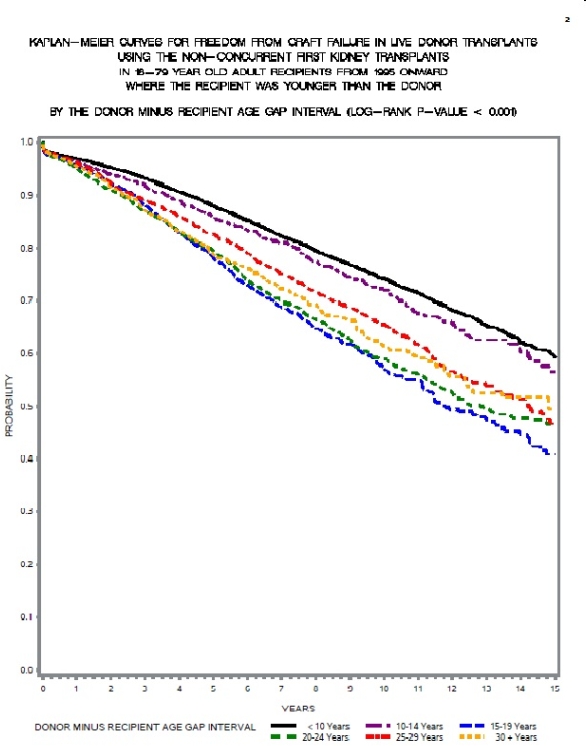Age Gap Analysis Between Live Donor and Recipients in Kidney Transplantation: Opportunities to Improve Voluntary Exchange Programs and Kidney Paired Donation.
J. Rodriguez,1 A. Patel,2 M. Goggins.2
1Internal Medicine, Henry Ford Hospital, Detroit, MI
2Transplant Institute, Henry Ford Hospital, Detroit, MI
3Transplant Institute, Henry Ford Hospital, Detroit, MI.
Meeting: 2016 American Transplant Congress
Abstract number: A145
Keywords: Donors, Graft survival, Kidney transplantation, Outcome, unrelated
Session Information
Session Name: Poster Session A: Kidney Donor Outcomes
Session Type: Poster Session
Date: Saturday, June 11, 2016
Session Time: 5:30pm-7:30pm
 Presentation Time: 5:30pm-7:30pm
Presentation Time: 5:30pm-7:30pm
Location: Halls C&D
Graft survival(GS) perception is that, with a smaller age gap between the donor(D) and recipient(R), better the outcome. It is unclear if there is an age-gap limit at which the benefit in GS disappears. We chose to analyze graft failure(GF)rates among R of living donors(LD) with an incremental D minus R age gap. We compared such groups to standard criteria deceased donors(SCD)transplants.
Methods: Using the UNOS database from 1995 to 2013, we evaluated GF involving LD with R ages 18-79 from 1995 onward. We compared GF among R from LD with an age-gap, D minus R, of <10, 10-14, 15-19, 20-24, 25-30 and 30+. These age-gap groups were compared to SCD R. D and R demographic and transplant data were used to allow Cox regression analysis. Endpoints were plotted using Kaplan-Meir analysis.
Results: When D are older than R, Cox regression analysis(n=13,930)showed no statistical difference in GF comparing a D-R age-gap less than 10 vs age-gap 10-14(p 0.636).There was a significant increase in GF in age-gap 15-19 (n=3,127)compared to 10-14 (P<0.001, HR 1.55).There was no GF difference comparing remaining age-gap groups.Kaplan-Meier curve confirmed findings.Fig1
Comparing LD R of same age-gap groups with R of SCD(n=29,058) a statistical significance decreased in GF was found between age-gap<15 (p<0.001, HR 0.67).There was no statistical difference between the wider age-gap groups and SCD R. When R are older than D, Cox regression analysis(n=41,881) showed that age-gap of <10 had statistically significant improved GF compared to age gap>10(p<0.001, HR 1.18)however, it was not significant when compared to age gap >15 (p=0.1).

Conclusions: There appears to be a statistical significant benefit on GF within LD R if the age-gap is <15 compared to age gap>15. Within age gap groups of >15, there was no difference in GF. LD R had decreased GF when compared to SCD R, if age gap was <15, but not if gap was>15.For R older than D,there is no GF benefit with an age gap of >15 compared to <15.
CITATION INFORMATION: Rodriguez J, Patel A, Goggins M. Age Gap Analysis Between Live Donor and Recipients in Kidney Transplantation: Opportunities to Improve Voluntary Exchange Programs and Kidney Paired Donation. Am J Transplant. 2016;16 (suppl 3).
To cite this abstract in AMA style:
Rodriguez J, Patel A, Goggins M. Age Gap Analysis Between Live Donor and Recipients in Kidney Transplantation: Opportunities to Improve Voluntary Exchange Programs and Kidney Paired Donation. [abstract]. Am J Transplant. 2016; 16 (suppl 3). https://atcmeetingabstracts.com/abstract/age-gap-analysis-between-live-donor-and-recipients-in-kidney-transplantation-opportunities-to-improve-voluntary-exchange-programs-and-kidney-paired-donation/. Accessed January 2, 2026.« Back to 2016 American Transplant Congress
